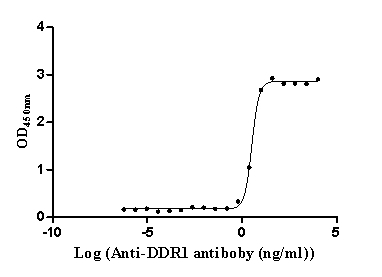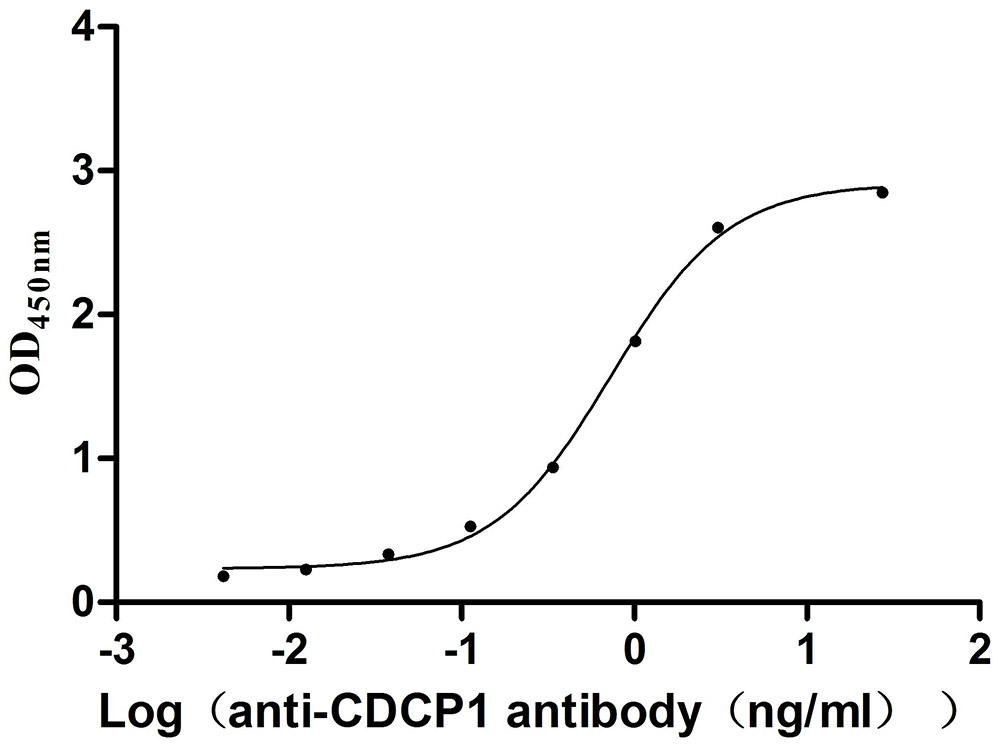Recombinant Human Tumor necrosis factor receptor superfamily member 6B (TNFRSF6B)
-
货号:CSB-YP023982HU
-
规格:
-
来源:Yeast
-
其他:
-
货号:CSB-EP023982HU
-
规格:
-
来源:E.coli
-
其他:
-
货号:CSB-EP023982HU-B
-
规格:
-
来源:E.coli
-
共轭:Avi-tag Biotinylated
E. coli biotin ligase (BirA) is highly specific in covalently attaching biotin to the 15 amino acid AviTag peptide. This recombinant protein was biotinylated in vivo by AviTag-BirA technology, which method is BriA catalyzes amide linkage between the biotin and the specific lysine of the AviTag.
-
其他:
-
货号:CSB-BP023982HU
-
规格:
-
来源:Baculovirus
-
其他:
产品详情
-
纯度:>85% (SDS-PAGE)
-
基因名:TNFRSF6B
-
Uniprot No.:
-
别名:DcR3; Decoy receptor 3; Decoy receptor for Fas ligand; DJ583P15.1.1; M68; M68E; OTTHUMP00000031583 ; TNF6B_HUMAN; TNFRSF6B; TR6; Tumor necrosis factor receptor superfamily member 6B; Tumor necrosis factor receptor superfamily member 6b decoy; UNQ186/PRO212
-
种属:Homo sapiens (Human)
-
蛋白长度:Full Length of Mature Protein
-
表达区域:30-300
-
氨基酸序列V AETPTYPWRD AETGERLVCA QCPPGTFVQR PCRRDSPTTC GPCPPRHYTQ FWNYLERCRY CNVLCGEREE EARACHATHN RACRCRTGFF AHAGFCLEHA SCPPGAGVIA PGTPSQNTQC QPCPPGTFSA SSSSSEQCQP HRNCTALGLA LNVPGSSSHD TLCTSCTGFP LSTRVPGAEE CERAVIDFVA FQDISIKRLQ RLLQALEAPE GWGPTPRAGR AALQLKLRRR LTELLGAQDG ALLVRLLQAL RVARMPGLER SVRERFLPVH
-
蛋白标签:Tag type will be determined during the manufacturing process.
The tag type will be determined during production process. If you have specified tag type, please tell us and we will develop the specified tag preferentially. -
产品提供形式:Lyophilized powder
Note: We will preferentially ship the format that we have in stock, however, if you have any special requirement for the format, please remark your requirement when placing the order, we will prepare according to your demand. -
复溶:We recommend that this vial be briefly centrifuged prior to opening to bring the contents to the bottom. Please reconstitute protein in deionized sterile water to a concentration of 0.1-1.0 mg/mL.We recommend to add 5-50% of glycerol (final concentration) and aliquot for long-term storage at -20℃/-80℃. Our default final concentration of glycerol is 50%. Customers could use it as reference.
-
储存条件:Store at -20°C/-80°C upon receipt, aliquoting is necessary for mutiple use. Avoid repeated freeze-thaw cycles.
-
保质期:The shelf life is related to many factors, storage state, buffer ingredients, storage temperature and the stability of the protein itself.
Generally, the shelf life of liquid form is 6 months at -20°C/-80°C. The shelf life of lyophilized form is 12 months at -20°C/-80°C. -
货期:Delivery time may differ from different purchasing way or location, please kindly consult your local distributors for specific delivery time.Note: All of our proteins are default shipped with normal blue ice packs, if you request to ship with dry ice, please communicate with us in advance and extra fees will be charged.
-
注意事项:Repeated freezing and thawing is not recommended. Store working aliquots at 4°C for up to one week.
-
Datasheet :Please contact us to get it.
相关产品
靶点详情
-
功能:Decoy receptor that can neutralize the cytotoxic ligands TNFS14/LIGHT, TNFSF15 and TNFSF6/FASL. Protects against apoptosis.
-
基因功能参考文献:
- The combination of decoy receptor 3, soluble urokinase type plasminogen activator receptor, and procalcitonin improved the sensitivity and specificity of diagnosis of sepsis, suggesting that use of the combination of three indexes enhanced the efficiency of sepsis diagnosis. PMID: 29760745
- Compared with the control, miR-340 was significantly lower in the serum of hepatocellular carcinoma patients (p<0.01). miR-340 was lower in HCC tissues than in adjacent; however, DcR3, TGF-beta1 and Smad2 were higher. PMID: 29311025
- DcR3 treatment caused HepG2 cell cytoskeleton remodeling, inhibited E-cadherin expression, and promoted cell migration. PMID: 28560426
- DcR3 gene polymorphisms are associated with sporadic breast infiltrating ductal carcinoma risk in Northeast Chinese females PMID: 27517320
- Study found that both transcriptional expression and post-transcriptional DcR3 expression DcR3 expression were significantly up-regulated in colorectal cancer (CRC) tissues. DcR3 was found to be playing a critical role in CRC proliferation and migration in vitro and in tumorigenesis and metastasis in vivo. PMID: 27764793
- Higher plasma DcR3 level was related to better coronary collateral circulation (CCC) formation and displayed potent predictive power for CCC status in patients with coronary artery disease. PMID: 28942284
- High serum DcR3 levels are associated with disease severity in nonatopic asthma patients. PMID: 26911723
- Results show that DcR3 engages TNF ligands: FasL, LIGHT, and TL1A in a structurally similar fashion and its promiscuity is due to recognition of backbone atoms and invariant side chains. PMID: 27806260
- when idiopathic pulmonary fibrosis cells interact with collagen matrix, aberrantly activated Akt increases DcR3 expression via GSK-3beta-NFATc1 and protects IPF cells from the FasL-dependent apoptotic pathway. PMID: 27218286
- Coexpression of TNFRSF6B and PCDHGA3 was observed immunohistochemically in FL18 cells, suggesting potential cooperation in tumor cell maintenance. PMID: 27748813
- Loss of DcR3 impaired the growth and invasive property of HCC cell line of HepG2. PMID: 27779171
- Overexpression of DcR3 was significantly related to the risk of female reproductive cancers (OR=10.69, 95% CI: 6.33-18.05), TNM stage (OR=5.51, 95% CI: 2.83-10.71), differentiation (OR=4.16, 95% CI: 2.28-7.60), lymph node metastasis (OR=5.89, 95% CI: 3.16-10.9), age (OR=0.85, 95% CI: 0.51-1.44), and overall survival time (OR=1.84, 95% CI: 0.58-5.83). PMID: 27246752
- The serum level of DcR3 may be a useful marker for disease activity in ANCA-associated renal vasculitis. PMID: 27251675
- The sDcR3 levels in patients with HIV-1 subtype B were significantly higher than those in patients infected with subtype CRF01_AE. HIV-1 subtype B and slow disease progression were associated with higher levels of sDcR3. PMID: 26062966
- DcR3 inhibits influenza a virus-induced JNK and ERK activation in human macrophages PMID: 25940317
- Decoy receptor 3 (DcR3) expression in kidneys has been shown to predict progression of chronic kidney disease. PMID: 26335204
- Decoy receptor 3 regulates the expression of tryptophan hydroxylase 1 in rheumatoid synovial fibroblasts PMID: 26238767
- tumour markers DcR3 and growth/differentiation factor (GDF)15 from 100 mul human serum, were quantified. PMID: 25823874
- Serum DcR3 expression in primary Sjogren's syndrome (pSS) patients was significantly higher than healthy controls. DcR3 expression in salivary glands of pSS patients was significantly higher than healthy controls. PMID: 25564309
- study has defined the increased serum and SF samples levels of TL1A and DcR3 in patients with rheumatoid arthritis (RA); findings support the hypothesis that TL1A and DcR3 may contribute to the pathogenesis of RA PMID: 25647275
- decoy receptor 3 and geriatric nutrition have a role in mortality in chronic hemodialysis patients PMID: 25323840
- Higher DcR3 expression was related to the status of invasion, lymph node metastasis and recurrence in bladder urothelial carcinoma. PMID: 25422191
- HER2 overexpression is not an independent prognostic marker of colorectal cancer, but DcR3 overexpression is highly correlated with lymph node metastasis and poor overall survival PMID: 24764685
- The overexpression of DcR3 might play a crucial role in the tumorigenesis, differentiation, and proliferation of glioma. PMID: 24741354
- Overexpression of TNFRSF6B is associated with hepatocellular carcinoma. PMID: 24998573
- A case-control study of esophageal squamous-cell carcinoma (ESCC)found that the DcR3 SNPs were not associated with the risk of ESCC. PMID: 24786982
- Inhibition of B cell functions by DcR3 may partially explain the negative correlation between DcR3 level and disease activity in rheumatoid arthritis patients. PMID: 25084482
- High serum DcR3 expression correlated with lymph node metastases in in pancreatic head carcinoma PMID: 24597666
- DcR3 is a key driver of tumor cell dissemination. PMID: 24107265
- DcR3 may play an etiologic role in systemic lupus erythematosus through either elevated serum levels of wild-type DcR3 or normal levels of gain-of-function DcR3 proteins that increase lymphocyte proliferation. PMID: 23729807
- Rare missense mutations in TNFRSF6B have a role in the pathogenesis of some cases of IBD. PMID: 23965943
- DCR3 is overexpressed in breast cancer and in vascular endothelial cells and tumor cells in the lymph nodes, revealing a possible link with lymphangiogenesis. PMID: 24612949
- Silencing of decoy receptor 3 (DcR3) expression by siRNA in pancreatic carcinoma cells induces Fas ligand-mediated apoptosis in vitro and in vivo. PMID: 23846297
- Our results implied the therapeutic potential of silencing DcR3 expression by RNAi in colon cancer. PMID: 24101127
- The findings in this study strongly suggest that DcR3 plays important roles in tumor progression of human MFH by decoy as well as non-decoy functions and that DcR3 may serve as a potent therapeutic target for human MFH. PMID: 23817777
- Serum DcR3 level may be useful for detecting Hepatitis Be Antigen (-) Chronic hepatitis B in the active stage, which requires medical treatment. PMID: 23925044
- DcR3 might regulate the gene expression of various key molecules in rheumatoid arthritis fibroblast-like synoviocytes by binding to TL1A. PMID: 23912906
- Data suggest DcR3 expression in DSV-PTC (diffuse sclerosing variant of papillary thyroid carcinoma) tumor cells promotes polarized macrophage differentiation toward the M2 phenotype and thus has role in recruitment of tumor-associated macrophages. PMID: 23186064
- high expression of TNFRSF6B is a novel biomarker for predicting the progression of chronic kidney disease PMID: 23449012
- DcR3 expression was associated with other prognostic factors including survivin, reduced remission rates, and shorter event-free survival. PMID: 23652586
- novel regulatory mechanisms of DcR3 expression in psoriasis, particularly in keratinocytes and endothelial cells, provides new insight into the pathogenesis of psoriasis PMID: 23707413
- DcR3 and ERK1/2 play a vital role in the development of gastric cancer, and they may be new markers for indicating the efficiency of gastric cancer treatment in the future. PMID: 22672288
- Higher DcR3 levels strongly correlate with inflammation and independently predict cardiovascular and all-cause mortality in CKD patients on hemodialysis. PMID: 22626963
- High expression and amplification of the DcR3 gene is associated with pancreatic carcinoma. PMID: 22524850
- These results imply that DcR3 may regulate B cell activation by suppressing the activation of NF-kappaB. PMID: 22581854
- The increased synovial inflammatory cells infiltration in rheumatoid arthritis and ankylosing spondylitis was associated with the elevated DCR3 expression. PMID: 22325083
- Significantly enhanced tumor growth and spreading are observed in DcR3-transgenic mice; DcR3-transfectant cells grow faster and result in infiltration by tumor-associated macrophages. PMID: 22287720
- The expression of DcR3 in vascular endothelial cells during the early phases of Kaposi's sarcoma-associated herpesvirus infection ensures the successful establishment and maintenance of the viral infection. PMID: 21293109
- DcR3-Fc inhibits the proliferation induced by TNFalpha or IL-1beta in rheumatoid arthritis. PMID: 21537832
- EMS1 expression was positively related to DcR3, which might play an important role in the carcinogenesis and development of laryngeal carcinoma. PMID: 21395182
显示更多
收起更多
-
亚细胞定位:Secreted.
-
组织特异性:Detected in fetal lung, brain and liver. Detected in adult stomach, spinal cord, lymph node, trachea, spleen, colon and lung. Highly expressed in several primary tumors from colon, stomach, rectum, esophagus and in SW480 colon carcinoma cells.
-
数据库链接:
HGNC: 11921
OMIM: 603361
KEGG: hsa:8771
STRING: 9606.ENSP00000359013
UniGene: Hs.434878
Most popular with customers
-
Recombinant Human CD226 antigen (CD226), partial (Active)
Express system: Mammalian cell
Species: Homo sapiens (Human)
-
Recombinant Human T-cell surface protein tactile (CD96), partial (Active)
Express system: Mammalian cell
Species: Homo sapiens (Human)
-
Recombinant Rat Intestinal-type alkaline phosphatase 1 (Alpi) (Active)
Express system: Mammalian cell
Species: Rattus norvegicus (Rat)
-
Recombinant Human Epithelial discoidin domain-containing receptor 1 (DDR1), partial (Active)
Express system: Mammalian cell
Species: Homo sapiens (Human)
-
Recombinant Dog B-lymphocyte antigen CD20 (MS4A1)-VLPs (Active)
Express system: Mammalian cell
Species: Canis lupus familiaris (Dog) (Canis familiaris)
-
Recombinant Mouse CUB domain-containing protein 1 (Cdcp1), partial (Active)
Express system: Mammalian cell
Species: Mus musculus (Mouse)
-
Recombinant Human Myosin regulatory light chain 12A (MYL12A) (Active)
Express system: E.coli
Species: Homo sapiens (Human)
-
Recombinant Macaca fascicularis Zinc transporter ZIP6 isoform X1(SLC39A6),partial (Active)
Express system: Baculovirus
Species: Macaca fascicularis (Crab-eating macaque) (Cynomolgus monkey)



-AC1.jpg)
















